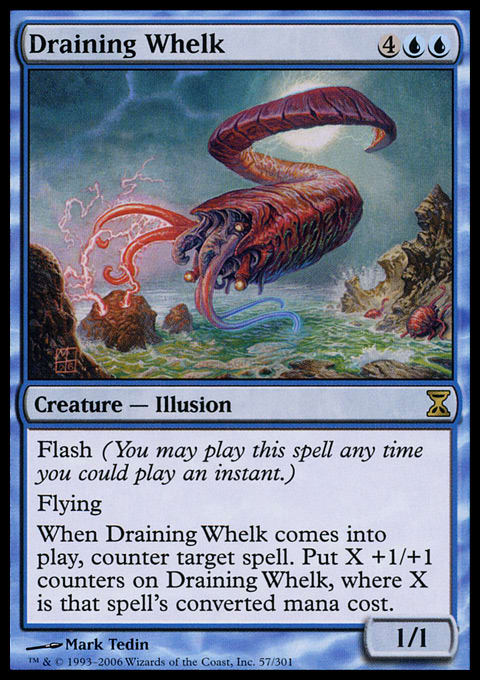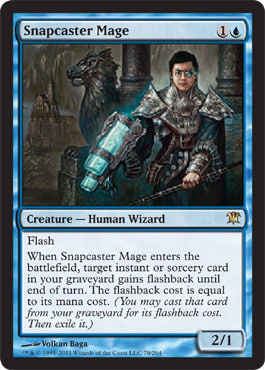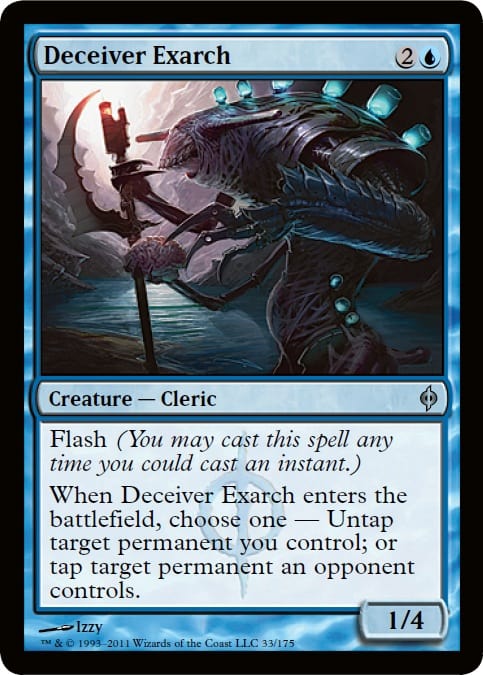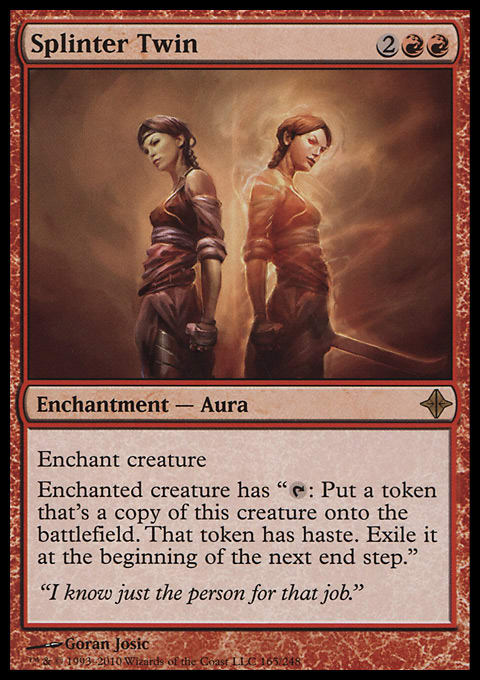Here's a little trivia to kick off this week's column: which Magic: the Gathering card contains the following flavor text (one of my all-time favorites). The name of the card is cited in the text so I replaced it with blanks--this could be a helpful hint.
If you find yourself and a friend being chased by a ______ _______, you have but one chance: Trip your friend. - Suq'Ata wisdom
For newer players, this may be a tricky one, since the card was first printed in Visions and hasn't seen a reprint since Ninth Edition. The answer is King Cheetah!
I remember eagerly playing this Green creature in my decks when I was a brand new player in 1997. The thought of ambushing my opponent's attacking creature with a creature of my own, that I can cast at instant speed, was an absolute thrill. They'll never see it coming.
Keyword: Flash
Players may recognize this rules text; it has since been consolidated into a single keyword: Flash. In fact, when you look up King Cheetah in Gatherer, the oracle card text is simply "Flash." Flash is a keyword ability that lets a player play a card any time they could cast an instant. To go a little deeper, it's a static ability that functions in any zone from which you could play the card it's on (e.g., your hand, exile, commander zone). Of course, multiple instances of flash on the same object are redundant.
This is one of those abilities that existed for many years before it finally became a keyword. Other older cards that have since been updated to contain the keyword Flash include Defender of Chaos, Defender of Law, Masako the Humorless, Needlebug, Raging Kavu, Rootwater Shaman, Simian Grunts, and Vine Dryad. Clearly, this was an ability that Wizards of the Coast liked using over and over.
Then in Time Spiral, in step with the time-warping theme of the block, Wizards finally created Flash as the keyword to indicate a card could be cast any time that an instant could be played. This made printing a creature that counters a spell, such as Draining Whelk, much cleaner to print.
By granting creatures Flash, they enabled a new vector of interaction between creatures and instant spells. In addition to counterspells, Flash creatures could bounce spells currently on the stack, flashback spells from one's graveyard, and interfere with combat by altering a creature's power and toughness. The ability to staple a common instant spell onto a creature became a major branch of development and exploration.
Since then, over 300 creatures have since been printed with Flash, across many of Magic's past sets. The keyword will be familiar even to brand new players, because Aetherdrift also contains cards with Flash, such as Fang Guardian.
Beyond creatures, other card types can also be printed with Flash. This is a common occurrence with certain auras that either buff one's own creatures or trip up an opponent's creature. Examples include Airtight Alibi, Alexi's Cloak (an old one), and Encase in Ice. Then there are non-aura enchantments with flash, such as Dress Down and Ashiok's Erasure. In total, over 100 enchantment cards have been printed with flash throughout Magic history.
The same kind of thing can be explored with artifacts like Baton of Courage, Embercleave, and Scale of Chiss-Goria. There's even one Planeswalker printed with Flash: The Wandering Emperor.
Clearly, Flash is a versatile ability that Wizards of the Coast has explored across card types and game situations, bringing the simple, yet powerful ability to life.
Iconic Cards with Flash
Since the first instance of Flash back in Visions, and since its official creation as a keyword in Time Spiral, numerous cards with Flash have had profound impact on the game. The Wandering Emperor, pictured above, was one of them. A Planeswalker with Flash is the perfect card for a heavy control deck, and was a mainstay during its time in Standard.
Speaking of control decks, an even more powerful and dominant card with Flash from Magic's history is Snapcaster Mage. I shudder just to think about the card and the profound impact it had across multiple constructed formats.
During its peak, Snapcaster Mage was a $70 rare because of how powerful and dominant it was in Standard, Modern, and Legacy. The Flash creature has since fallen out of favor, but the ability to cast a cheap creature at instant speed while also rebuying an instant or sorcery card from your graveyard created a one-two punch that was extremely powerful at the time.
Torrential Gearhulk cost more mana and gave you a bigger body and flashed back your spell for free. This was another impactful creature that controlling decks loved to play in an older version of Standard.
More recently, one Enchantment with Flash that has been seeing significant play is Leyline Binding.
With a diverse enough mana base, Leyline Binding is an Enchantment with Flash that can exile an opponent's most problematic nonland permanent for as little as one White mana. The card would not be nearly as potent if it didn't include the Flash keyword. Despite the recent shifts in Standard to more aggressive builds, Leyline Binding continues to be a top 50 card in Standard.
In an older Standard, Cast Out was a similar removal spell that had Flash. Its power came in the form of its Flash keyword ability alongside cycling, making it a versatile spell in its own right.
Even more prevalent in the current Standard metagame is another Flash Enchantment removal spell: Nowhere to Run.
This Enchantment enables you to kill creatures at instant speed while also circumventing pesky ward and hexproof abilities. Since it's an Enchantment, it has added versatility because you can return it to your hand with cards like This Town Ain't Big Enough. Then you can cast it at instant speed yet again, killing another creature. Like Leyline Binding, Nowhere to Run would not be nearly as powerful as it currently is without that Flash keyword printed on it.
Pivoting back to creatures with Flash, you can find a long list of impactful cards. Brazen Borrower was a menace during its time in Standard. Containment Priest has been a powerful Flash creature out of the sideboard in Eternal formats. Who could forget the two-card, infinite combo Splinter Twin with Deceiver Exarch. At the end of your opponent's turn, you'd flash in the creature and then slam Splinter Twin during your next turn.
There's a cycle of creatures with Flash in Modern Horizons 2 that see a bit of play: Endurance, Subtlety, and Solitude (Interestingly, Fury and Grief are banned in Modern despite not having Flash). Orcish Bowmasters is a dominant creature in Vintage Cube for its favorable interaction with draw sevens like Wheel of Fortune and Timetwister.
Who could forget Thieves' Guild Enforcer's 15 minutes of fame in Standard when milling opponents out with Rogues? I've seen Tishana's Tidebinder in many Standard sideboards for its ability to interfere with activated and triggered abilities at instant speed.
The list goes on.
Granting Flash
Before wrapping up, I want to briefly talk about a couple iconic cards that don't have Flash themselves, but grant the ability to play certain spells at instant speed or similar derivative to Flash.
Let's start with the namesake, Flash.
Perhaps inspiration for the keyword, Flash was an Instant spell from Mirage (since reprinted in a couple sets) that allowed you to place any creature from your hand directly into play. To offset the cost of Flash itself, your cost for placing the creature into play was its casting cost reduced by two generic mana. In theory this made perfect sense. In practice, however, the card was printed in a way that enabled broken combinations.
If the card stated, "The next creature you cast this turn may be played any time you could play an Instant, and its casting cost is reduced by 2," you may not have had problems. Funnily enough, the card was errata'd for years to implement this change. Wizards ultimately decided to revert the card back to the way it was printed, where you placed the creature directly into play and then had to pay its casting cost reduced by 2. You could choose not to pay the cost and bury the creature, but you still get all the enter the battlefield and dying triggers that come along with the creature.
The result was a multitude of combos that became unstoppable and out of control. One powerful idea is to combine Flash with Protean Hulk, where you Flash in Protean Hulk, let it die, search up Karmic Guide and Carrion Feeder, reanimate Protean Hulk with Karmic Guide, sacrifice it to Carrion Feeder for another trigger, fetch Kiki-Jiki, Mirror Breaker, use Kiki-Jiki, Mirror Breaker to copy Karmic Guide and sacrifice Kiki-Jiki to Carrion Feeder in response, which lets you reanimate with the Guide's ability. Repeat this loop to generate a billion Karmic Guides and attack for lethal. This kind of interaction has forced Wizards to ban Flash in both Legacy and Commander.
The other noteworthy card that grants Flash and has been problematic over the years is Aluren.
This four mana Enchantment not only grants Flash to your creatures of three mana or less, but also lets you play them for free! It doesn't take a rules expert to understand how this card can be broken. In combination with Cavern Harpy, Baleful Strix, and Ice-Fang Coatl, you have a potent combination that draws numerous cards at instant speed. I don't believe Flash has ever been banned, but it's always been on the fringe as an offbeat Legacy strategy.
There are dozens of other cards that grant Flash in one form or another (Quicken is one of my favorites), but none have been as dramatically impactful as these two cards.
Wrapping It Up
Flash has been around for longer than you may have imagined. The ability to cast a non-instant spell any time you could play an instant was first printed on a card all the way back in Visions, when King Cheetah hit the scenes. Since then, we've seen cards of all types printed with the Flash keyword, ambushing opponents and taking them by surprise in the process. The card Ambush Viper is sometimes used to describe a creature that can be flashed into play to block and kill an opponent's attacking creature.
Now, almost 30 years later, Flash is an evergreen mechanic that shows up in many sets. The keyword enables a great deal of interesting interactions during combat. It also gives more versatility when creating creatures that also can impact spells and abilities on the stack. The result is a more sophisticated and interesting gameplay experience, especially in Limited.
The ability has also had profound impacts on Standard and Eternal formats over the years. Sometimes such an effect can be so powerful, it even gets banned (namely, the keywords eponymous card, Flash). Fortunately, Wizards has only banned one or two cards with Flash. Hullbreacher, for example, is banned in Commander. On the whole, with the right balance of power and the added diversity to Magic, we can certainly expect to see cards with Flash printed for years to come.

































